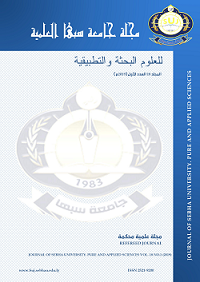Estimation of the surface runoff depth of Wadi Derna Basin by integrating the geographic information systems and Soil Conservation Service (SCS-CN) model
Abstract
Precipitation and runoff are the important hydrologic component in the water resources assessment. Many methods are available to estimate surface runoff from rainfall; however, the SCS-CN method remains the most popular and frequently used method as runoff curve number (CN) is a crucial factor of the SCS-CN method and depends on land use/land cover (LC/LU), soil type, and antecedent soil moisture (AMC). This approach with the geographic information system (GIS) was applied for estimating runoff volume of Wadi Derna Basin. Soil maps were processed and classified into hydrologic soil groups (HSG), where the dominant HSG in the study area is D. The HSG and LULC layers were intersected and the CN values and the weighted curve number for each antecedent moisture (AMC) condition were assigned. As a result of the model applied, the annual runoff volume for forty years during 1960–2000 in the study area was estimated by 138.51 Mm3. Furthermore, a volume flood has been estimated, based on the flood of October 1945 and late November 1986. Those events called for average precipitation of 145 and 64.14mm respectively. The rainfall of 1945 produced a volume flood of 53.36 Mm3, which represents 40 % of annual runoff volume, while the flood of November 1986 was 14.8 Mm3, which is in good agreement with the recorded flood in the basin. The results demonstrated that the study area has a high potential for flood risk. Therefore, dams of Wadi Derna basin is needed periodic maintenance. Moreover, increasing vegetation cover is required to reduce the phenomenon of desertification.
Full text article
References
Soulis, K. X. 2021. Soil conservation service curve number (SCS-CN) method: Current applications, remaining challenges, and future Perspectives, journal of Water, 13 (2).
Jahan, K., Pradhanang, S. M., Bhuiyan M. A. E. 2021.Surface runoff responses to suburban growth: An integration of remote sensing, gis, and curve number, journal of Land, 10 (5): 1–18.
Caletka, M., Michalková, M. Š., Karásek, P., & Fučík, P. Improvement of SCS-CN initial abstraction coefficient in the Czech Republic: A study of five catchments, journal of Water, 12(7): 1–28.
المزوغي، طارق حامد ، عون، عمر ضو. 2017. دراسة الخصائص المورفومترية لحوض وادي غان باستخدام نظم المعلومات الجغرافية.، المؤتمر الدولي الثالث للتقنيات الجيومكانية، ليبيا، طرابلس.
Zamot, J., Afkareen, M.Geomorphological parameters by remote sensing and GIS techniques (A case study of flash flood in Mikhili Village, Al Jabal Al Akhdar, NE of Libya), In The forth international conference for geospatial technologies–Libya GeoTec, vol. 4. 2020.
الضراط، علاء جابر، 2020. التقييم الكمي للجريان السطحي في وادي الكراث طبرق شمال شرق ليبيا: دراسة هيدرومورفومترية.، مجلة جامعة صبراتة العلمية، المجلد الرابع، العدد الثاني.
الغرياني، مباركة سعد، 2015. توظيف تقنية نظم المعلومات الجغرافية لتقدير الجريان السطحي لوادي كعام بطريقة SCS-CN الأمريكية لحفظ التربة.، المؤتمر الدولي الأول للتقنيات الجيومكانية، طرابلس، ليبيا.
الرياني، عبدالرحمن أحمد و المدني، عبدالحكيم مسعود و خماج، أحمد أبراهيم. 2019 . تقدير الجريان السطحي لبعض أحواض الأودية في شمال غرب ليبيا. المجلة الليبية للعلوم الزراعية، المجلد 24 ، العدد 1.
بن طاهر، لبنى سليمان.2022. تقدير حجم السيول بحوض وادي القطارة جنوب شرق مدينة بنغازي - ليبيا بالتكامل بين نموذج الهيئة الامريكية لحماية الاراض ( SCS ) و تقنيات نظم معلومات الجغر افية و الاستشعار عن بعد. مجلة سبها للعلوم البحتة والتطبيقية، المجلد 21 العدد الأول.
Ashmawy , M., Abd El-Wah, M., Kamh, S., Abdal Azim, F. 2014. Drainage Morphometry and Its Influence on Runoff of El - Kouf Watershed, Ne, Libya – a Remote Sensing and Gis Approach, 2nd Scientific Conf. for Environment and Sustainable Development in Arid and Semi-Arid Regions, Ajdabiya, Libya, 14-16 Jan.
Hamad, S. 2020. Surface runoff estimation of Wadi Ba Al-Arid watershed NE Libya using SCS-CN, GIS and RS data, Iranian Journal of Earth Sciences, 12(3), 168-175.
HIDROPROJEKAT, 1972. Wadi Derna Projekt: flood protection of Derna Town. Ministry of Agriculture, Libya.
STOCKY, 2003. Determination of the 1’000- year flood of Derna and BU Mansur Reservoirs, Ministry of Agriculture, Libya.
ElOsta, M. M., Masoud, M. H. 2015. Implementation of a hydrologic model and GIS for estimating Wadi runoff in Dernah area, Al Jabal Al Akhadar, NE Libya,” Journal of African Earth Sciences, 107: 36-56.
سعد، مفتاح موسى و عوض، عبدالواحد عوض. 2020. التحليل الجيمورفولوجي لحوض وادي درنة. مجلة المختار للعلوم الأنسانية، العدد 38 .
وزارة الزراعة ليبيا طرابلس. 2006. مشروع التخريط الزراعي. طرابلس، ليبيا.
Nwer, B. A. B. 2005. The Application of Land Evaluation Technique in the north-east of Libya,” Natl. Soil Resour. Inst. , Fac. Environ., vol. PhD Thesis, p. 340, 2005.
بوبيضة، عبدالجواد أبوبكر، 2011. تقرير حول الأخطار المحتملة لفيضانات وادي درنه وسبل تفاديها. الجمعية الليبية للتخطيط والتنمية المستدامة، نشر بموقع https://lapsd.wordpress.com/.
USDA, Soil Conservation Service. National Engineering Handbook; Sec. 4. Hydrology; USDA: Washington, DC, USA, 1972.
Authors
Copyright (c) 2022 Journal of Pure & Applied Sciences

This work is licensed under a Creative Commons Attribution 4.0 International License.
In a brief statement, the rights relate to the publication and distribution of research published in the journal of the University of Sebha where authors who have published their articles in the journal of the university of Sebha should how they can use or distribute their articles. They reserve all their rights to the published works, such as (but not limited to) the following rights:
- Copyright and other property rights related to the article, such as patent rights.
- Research published in the journal of the University of Sebha and used in its future works, including lectures and books, the right to reproduce articles for their own purposes, and the right to self-archive their articles.
- The right to enter a separate article, or for a non-exclusive distribution of their article with an acknowledgment of its initial publication in the journal of Sebha University.
Privacy Statement The names and e-mail addresses entered on the Sabha University Journal site will be used for the aforementioned purposes only and for which they were used.





